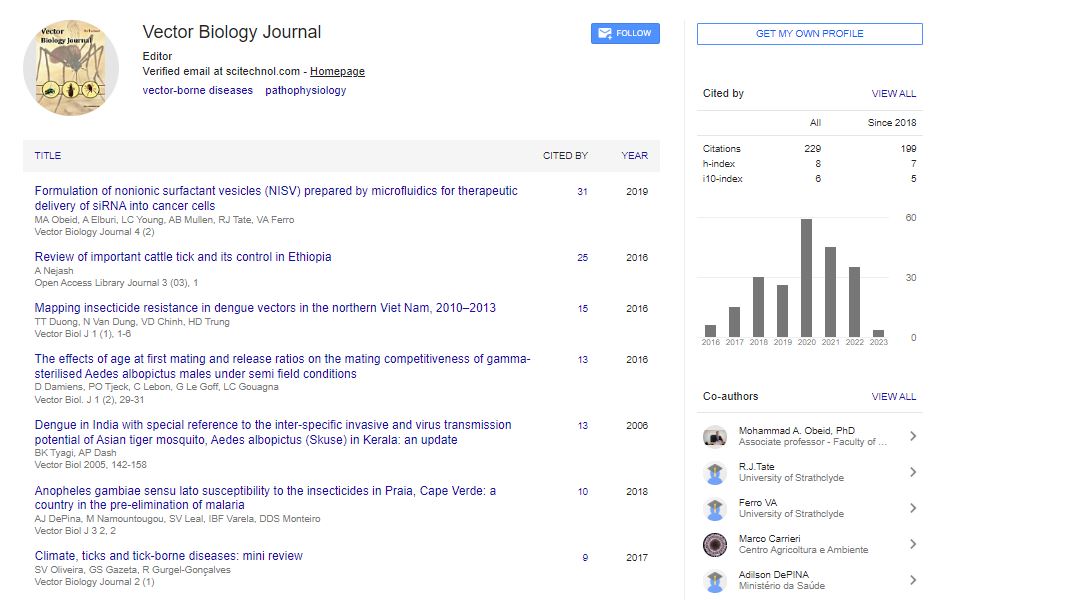Perspective, Vector Biol J Vol: 8 Issue: 4
Exploring Vector Ecology: Understanding the Dynamics of Disease Transmission
Saita Suya*
1Department of Biology, Sojo University, Kumamoto, Japan
*Corresponding Author: Saita Suya,
Department of Biology, Sojo University,
Kumamoto, Japan
E-mail: suya.sa@gmail.com
Received date: 21 November, 2023, Manuscript No. VBJ-24-127796;
Editor assigned date: 23 November, 2023, PreQC No. VBJ-24-127796 (PQ);
Reviewed date: 07 December, 2023, QC No. VBJ-24-127796;
Revised date: 15 December, 2023, Manuscript No. VBJ-24-127796 (R);
Published date: 22 December, 2023, DOI: 10.4172/2473-4810.1000273.
Citation: Suya S (2023) Exploring Vector Ecology: Understanding the Dynamics of Disease Transmission. Vector Biol J 8:4.
Description
Vector ecology plays an important role in the transmission dynamics of various infectious diseases, including malaria, dengue fever, Zika virus, and Lyme disease. Understanding the complex interactions between vectors, hosts, and the environment is essential for developing effective techniques to control and mitigate the impact of vector-borne diseases on human populations.
Vectors are organisms, typically arthropods such as mosquitoes, ticks, and sandflies that transmit pathogens from one host to another host. These organisms serve as the bridge between infected hosts and susceptible individuals, facilitating the spread of diseases within populations. The biology of vectors plays an essential role in determining the transmission dynamics of vector-borne diseases. Factors such as vector species, life cycle characteristics, feeding preferences, and vector competence influence the efficiency and potential for disease transmission.
Vector habitats encompass a wide range of natural and humanmodified environments that provide suitable conditions for vector breeding, development, and survival. For example, mosquitoes reproduce in stagnant water sources such as ponds, marshes, and manmade containers, but ticks flourish in forested places with high vegetation. Urbanization, deforestation, and climate change can alter vector habitats, leading to changes in vector distribution and abundance, and consequently, disease transmission patterns.
Vector behaviors, including host-seeking, blood-feeding, and resting patterns, also influence disease transmission dynamics.
Mosquitoes exhibit specific behaviors related to their efforts for blood meals, such as host preference, time of feeding, and location. Understanding these behaviors is essential for targeting vector control interventions effectively. For instance, indoor residual spraying and the use of insecticide-treated bed nets target mosquitoes during their resting periods, while larval source management aims to disrupt mosquito breeding habitats.
Environmental factors, such as temperature, humidity, rainfall, and land use, play a significant role in shaping vector ecology and disease transmission dynamics. Temperature influences vector development rates, survival, and the replication of pathogens within vectors. Changes in temperature and precipitation patterns associated with climate change can alter the distribution and abundance of vectors, leading to shifts in disease transmission patterns and expanding the geographical range of vector-borne diseases.
The ecology of vector-borne diseases is further influenced by interactions between vectors, hosts, and pathogens within complex ecological systems. Vector species exhibit variations in their capacity to transmit pathogens, known as vector competence, which is influenced by genetic factors, environmental conditions, and interactions with other microorganisms. Additionally, host species diversity and abundance can influence vector feeding patterns and the maintenance of transmission cycles within ecosystems.
Vector control techniques aim to disrupt disease transmission by targeting vectors, hosts, or the pathogen essentially. Integrated vector management methods combine multiple interventions, such as vector surveillance, habitat modification, insecticide application, and community engagement, to reduce vector populations and minimize disease risk. However, the effectiveness of vector control measures depends on factors such as vector species, habitat characteristics, and socio-economic factors influencing community participation and compliance with control interventions.
Advances in technology, such as remote sensing, Geographic Information Systems (GIS), and molecular techniques, have enhanced our ability to monitor vector populations, predict disease outbreaks, and target control efforts more effectively. Remote sensing data can provide information on environmental variables associated with vector habitats, while GIS tools facilitate spatial analysis and the mapping of disease risk areas. Molecular techniques, such as Polymerase Chain Reaction (PCR) and next-generation sequencing, enable the detection and characterization of vector-borne pathogens, aiding in disease surveillance and epidemiological study.
 Spanish
Spanish  Chinese
Chinese  Russian
Russian  German
German  French
French  Japanese
Japanese  Portuguese
Portuguese  Hindi
Hindi 